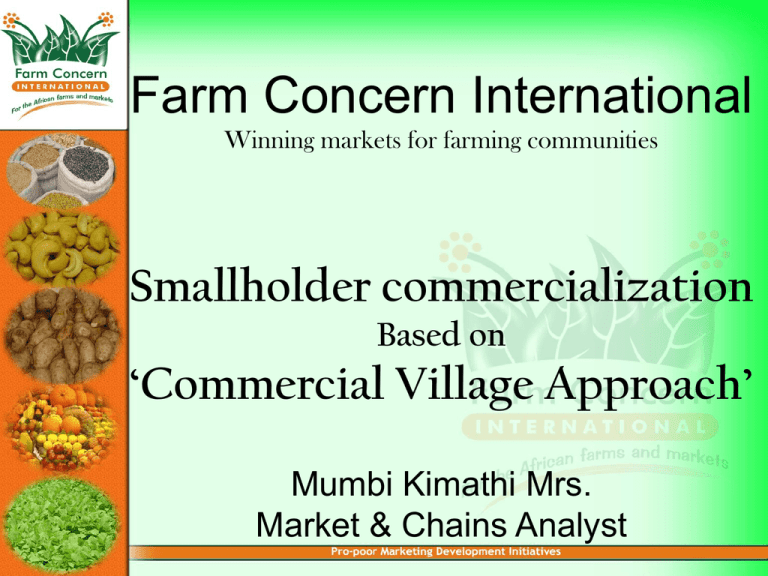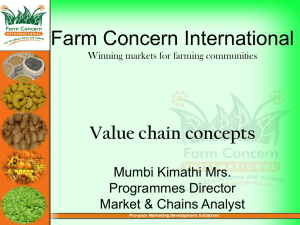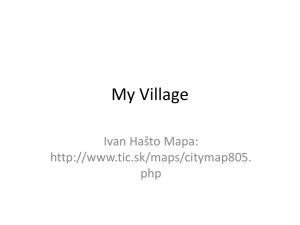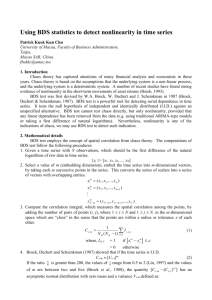smallholder commercialization
advertisement

Farm Concern International Winning markets for farming communities Smallholder commercialization Based on ‘Commercial Village Approach’ Mumbi Kimathi Mrs. Market & Chains Analyst Two Roads In farming Life PLAN TO PRODUCE FIND MARKETS PRODUCE HARVEST “road less traveled” Boom “road for most” Burst PRODUCE IDENTIFY MARKET Cassava Flour Trading Challenges in Kampala 50% Poor quality 44% Price flactuations 40% Low dem and 30% 22% none 20% 11% 11% 11% 11% 11% 10% scarcity High buying price High taxes 0% 40 35 30 Local m illers 36 Distant Millers 27 25 20 Brokers 18 18 15 10 5 0 9 Farm gate Ow n produce Trigger commercialization • • • • • • • • • Identify markets Conduct value chain analysis Identify routes for market entry Develop value chain partnerships Prioritize products from farmers’ basket – avoid wide range or too narrow range Conduct Cost Benefit Analysis along the Farm-to-Market chain Assess target farmers Agro-ecological zone analysis BDS Mapping Zone Characteristics Village status Description Value Chain Status Zone 4 Commercial BDS systems established Relatively high investment levels Medium / large –scale farmers Low poverty index High private sector investments Cash economy Active regional and global value chains Well established business partnerships Cash economy Developed / Commercialized Zone 3 Semi-commercial production systems Active local value chains Weak national / regional value chains Relatively seasonal value chain Semi-commercial BDS system Relatively developed marketing infrastructure Seasonal cash economy Intermediate Zone 2 Interest by players Inconsistent value chains Under-developed Marketing infrastructure Mix of food and cash economy Semi commercial production systems Developing Zone 1 Minimally identifiable value chains and BDS systems Largely food economy Minimal economic activities Large parcels of land characterized by low productivity Remotely developed Zone 0 Totally underdeveloped value chains Food economy No identified economic activities No BDS systems No highlighted interest by buyers Totally undeveloped Cash economy Commercial Village Approach • Commercialize typical African Village • Clusters of producers groups within a village setting • Comm. Vill.: 500 Households • Currently: 60,000 HH ( Avg. 6 members/HH) • Village co-ordination unit • Multileveled leadership structure – – – – – Executive committees Commercialization S-B Marketing S-B Financial S-B Social S-B African Traditional Vegetables cont… Case study • Consumption for ATV in Nairobi has increased from 31 Tonnes in 2003 with an estimated farm gate value of US$ 6,000 to • A current 600 Tonnes in 2006 with an estimated farm gate value of US$ 142,860 • Farm gate prices increased by 30% and the current supply of 500 Tonnes is estimated to account for 60% of the demand level. • The ATV distribution network includes supermarkets, kiosks, informal markets and street markets. Bridging gap btw poverty & creditworthiness • Trigger commercialization • Market Access Financial Services (MacFis), a pro-poor credit line • Graduation from MacFis after 2 years, market support offered for 4 years • Commercial Village Financial Services – Commercialization triggered through input credit for poor communities – Mandatory savings from sales – Repayment for loan recovered from payments Farm Concern Intl’ among 5 global winners of Pro-Poor Innovative Challenge[ PPIC] CGAP









